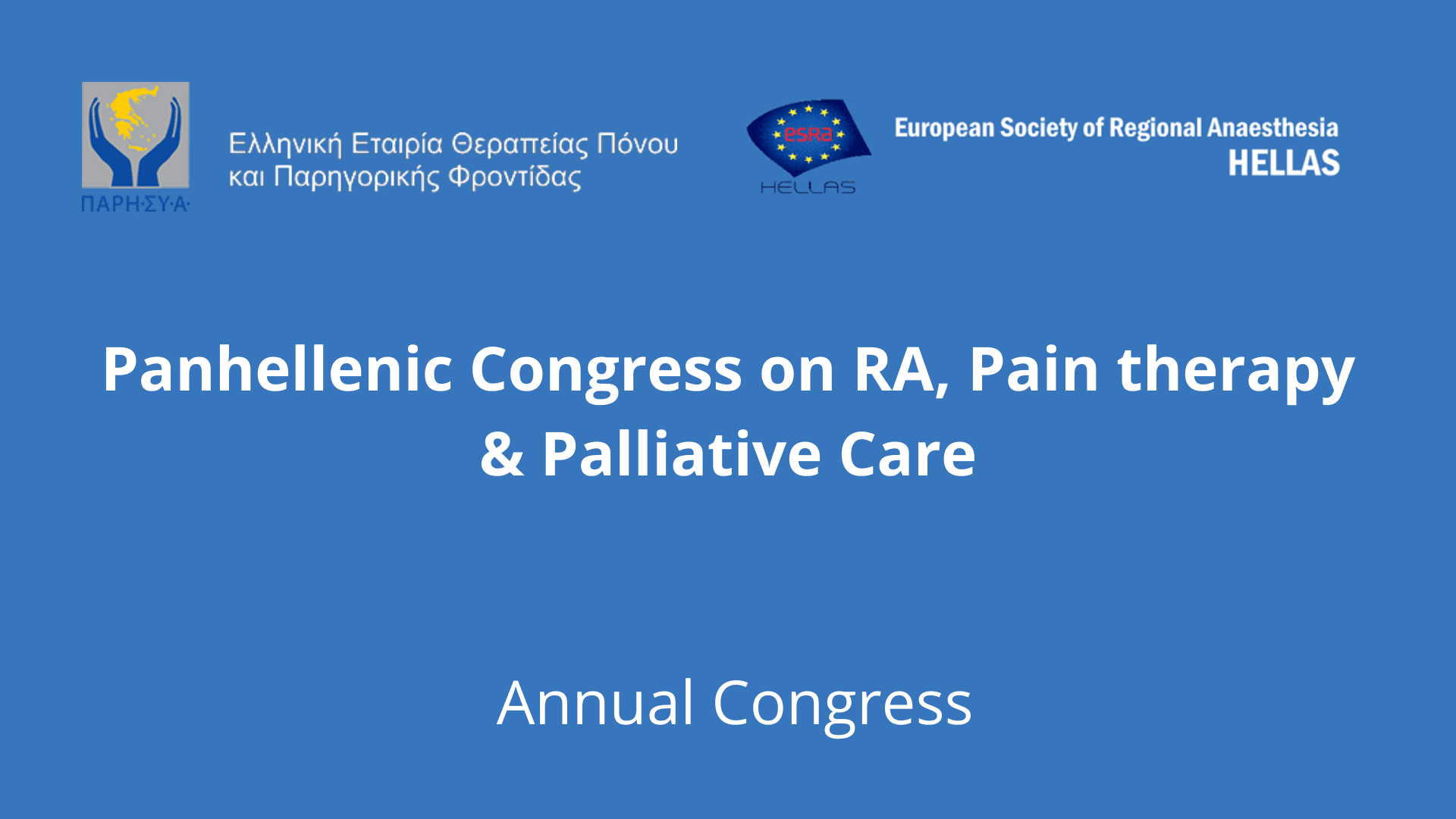SPINAL ANAESTHESIA – NEWER DEVELOPMENTS: THE ROLE OF ADJUVANTS

ESRA Highlights
23rd Annual ESRA Congress
September 8 – 11, 2004, Athens, Greece
Congress Highlights
SPINAL ANAESTHESIA – NEWER DEVELOPMENTS: THE ROLE OF ADJUVANTS
Athina Vadalouca
Pain Relief and Palliative Care Centre
Aretaieion University Hospital, University of Athens, Greece
For full text in pdf form click here.
The use of adjuvant drugs for Regional Anaesthesia (RA)is intended to prolong local anaesthetic analgesia and avoid their toxic doses. The action of the second drug added to the local anaesthetic is directed towards decreasing the sensory input to CNS.
Thus, a major advance in improving the success of RA has been achieved. The adjuvant drugs act at secondary site of action different to that of the local anaesthetic. The adjuvant drugs used today for RA are:
-
Vasoconstrictors
-
Opioids
-
a2 – adrenergic agonists
-
NMDA receptor antagonists
-
Cholinergic Agonists
In the future, the role of calcitonin, octreotide, adenosine and antioxidants will have to be considered [1].
Vasoconstrictors
For many years, vasoconstrictors were the only adjuvant drugs used in RA and even today they are commonly used. The addition of epinephrine, to the solution prolongs the blockade period by approximately 50% and decreases the systemic absorption of LA by approximately one third.
The addition of epinephrine to procaine prolongs sensory and motor block by 25%. However it is associated with a high incidence of nausea and the possibility of systemic toxicity [2].
Opioids
The placement of opioids in the epidural or subarachnoid space is based on the knowledge that opioid receptors are present in the substantia gelatinosa of the spinal cord.
Opioid Receptors are classified as:
-
μ – receptors (μ1, μ2)
-
δ – receptors and
-
κ – receptors
The analgesia induced by spinal opioids can be summarized as:
1) Direct inhibitory action on the dorsal horn of the spinal cord
2) Indirect effects inducing the release of non – opioid inhibitory transmitters or modulators
This year, Vath JS et al proved that adding fentanyl to spinal 2 – chloroprocaine (40 mg) appears to lengthen the regression to L1 dermotome and tourniquet time, while minimally lengthening the duration of block [3].
The addition of fentanyl to lidocaine results in effective spinal anaesthesia, with rapid recovery and low incidence of significant side effects for outpatient surgery [4].
For labour analgesia, the administration of 12.5 mcg of fentanyl with bupivacaine 2 mg in the spinal space provides analgesia for at least 85 minutes.
For the elderly, 4 mg bupivacaine with 25 mcg fentanyl provides good analgesia and fewer side effects [5].
The most serious side – effects of neuraxial opioids is respiratory depression. Obstetric patients appear to be at less risk of ventilatory depression perhaps because of increased ventilatory stimulation provided by progesterone. For opioids to be used safely and effectively as adjuvant drugs in spinal anaesthesia, adequate monitoring of vital parametres is necessary [1].
α2 – Adrenergic Agonists
α2 – Adrenergic Agonists such as clonidine, dexmedetomidine, and tizanidine exert action on the descending inhibitory monoaminergic tract, resulting in antinociceptive effect. Clonidine was first used epidurally in 1984 by Torsten Gordth. In the epidural and subarachnoid space, clonidine produces dose – dependent analgesia but does not lead to ventilatory depression, pruritus, nausea or vomiting.
The use of clonidine as an adjuvant drug in the field of regional anaesthesia in children seems to be very effective and safer than opioids and adrenaline [6].
Clonidine 1 mcg/kg, added to spinal isobaric bupivacaine, doubles the duration of the block in neonates without significant deleterious haemodynamic or respiratory effects.
There is clear evidence that a fixed dose of clonidine intramuscularly, epidurally or intrathecally has a clear order of duration: Intrahtecal > Epidural > Intramuscular. This therefore supports intrathecal administration.
The addition of 15 mcg clonidine to hyperbaric bupivacaine (6 mg) increases the spread of analgesia, prolongs the time to the first analgesic request and reduces postoperative pain.
Ketamine
Ketamine is a classic iv drug in that it works as an anaesthetic, sedative, amnesic and analgesic. It is a phenylcyclidine derivative that produces dissociative anaesthesia and has S+ and R- isomers. Ketamine is an NMDA receptor antagonist and was first used intrathecally by Bion in 1984.
This year, Togal et al, suggested that S+ ketamine administered spinally with a low dose of bupivacaine, provides shorter motor and sensory block onset time, shorter duration of action and less motor blockade in elderly males [7].
Ketamine administered intrathecally can achieve surgical anaeshtesia, and ketamine administered intraspinally in pigs has been shown to produce lower haemodynamic alterations in comparison with lidocaine [1]. Ketamine administered intrathecally is a promising analgesic alternative for women in labour, although its use is still at an early clinical stage. Ketamine administered epidurally for gynaecological procedures provides good postoperative analgesia, with no ventilatory depression and no side effects.
Neostigmine
Neostigmine administered epidurally inhibits nociception in a dose – dependent manner by increasing the endogenous neurotransmitter acetylcholine. However, there is skepticism about side effects and thus there is a need to investigate the ultra – low dose of neostigmine combined with other analgesics in order to avoid adverse effects. 1 – 5 mcg of neostigmine together with 100 mcg of morphine administered spinally doubles the duration to first rescue analgesic and reduces the analgesic consumption in 24 hours [8].
The addition of neostigmine and clonidine to bupivacaine ad fentanyl in obstetric labour analgesia increases the duration of labour analgesia, but also increases nausea.
Adenosine
Adenosine is an endogenous nucleoside that is present in all body cells. Adenosine receptors are in the superficial layers of the dorsal horn of the spinal cord and the antinociceptive effect of adenosine is probably mediated through A1 subtype receptors. For this reason it increases the pain threshold.
Administered intrathecally in a dose of 2000 mcg, Adenosine leads to transient lumbar pain but there is no motor block, no hypotension and no sedation.
Somatostatin – Octreotide
There have been reports that somatostatin and octreotide can alleviate postoperative and severe cancer pain if given epidurally or intraspinally.
Calcitonin
There is rich literature regarding spinal and epidural administration of calcitonin for cancer pain but few references regarding its successful use in postoperative pain.
In conclusion, future studies will prove to be increasingly important in terms of monitoring the risk – to – benefit ratio from the use of novel adjuvant drugs.
References
-
Vadalouca A. Adjuvant Drugs. Chapter in Textbook of Regional Anaeshtesia; PP Raj, Churchill Livingstone, 2002: pages 215 – 229.
-
Bergaron L et al. Spinal Procaine with and without epinephrine and its relation to transfer radicular irritation. Can J Anaesth, 1999; 46:846 – 849.
-
Vatz JS et al. Spinal 2 – chloroprocaine: The effect of added fentanyl. Anesth Analg, 2004; 98 (1): 89 – 94.
-
Urmey WF. Spinal anaesthesia for outpatient surgery. Best Pract Res Clin Anaesthesiol, 2003; 17 (3): 335 – 346.
-
Goyagi T et al. The addition of epinephrine enhances postoperative analgesia by intrathecal morphine. Anesth Analg, 1999; 81: 508 – 513.
-
Rochette A et al. Clonidine prolongs spinal anaeshtesia in newborns: A prospective dose rating study. Anesth Analg, 2004; 98: 56 – 59.
-
Togel T et al. Efficacy of S(+) Ketamine added to bupivacaine for spinal anaesthesia for prostate surgery in elderly patients. Eur J Anaesthesiol, 2004; 21 (3): 193 – 197.
-
Almeide RA et al. Antinociceptive effect of low – dose intrathecal neostigmine combined with intrathecal morphine following gynaecological surgery. Anesthesiology, 2003; 98 (2): 495 – 498.






